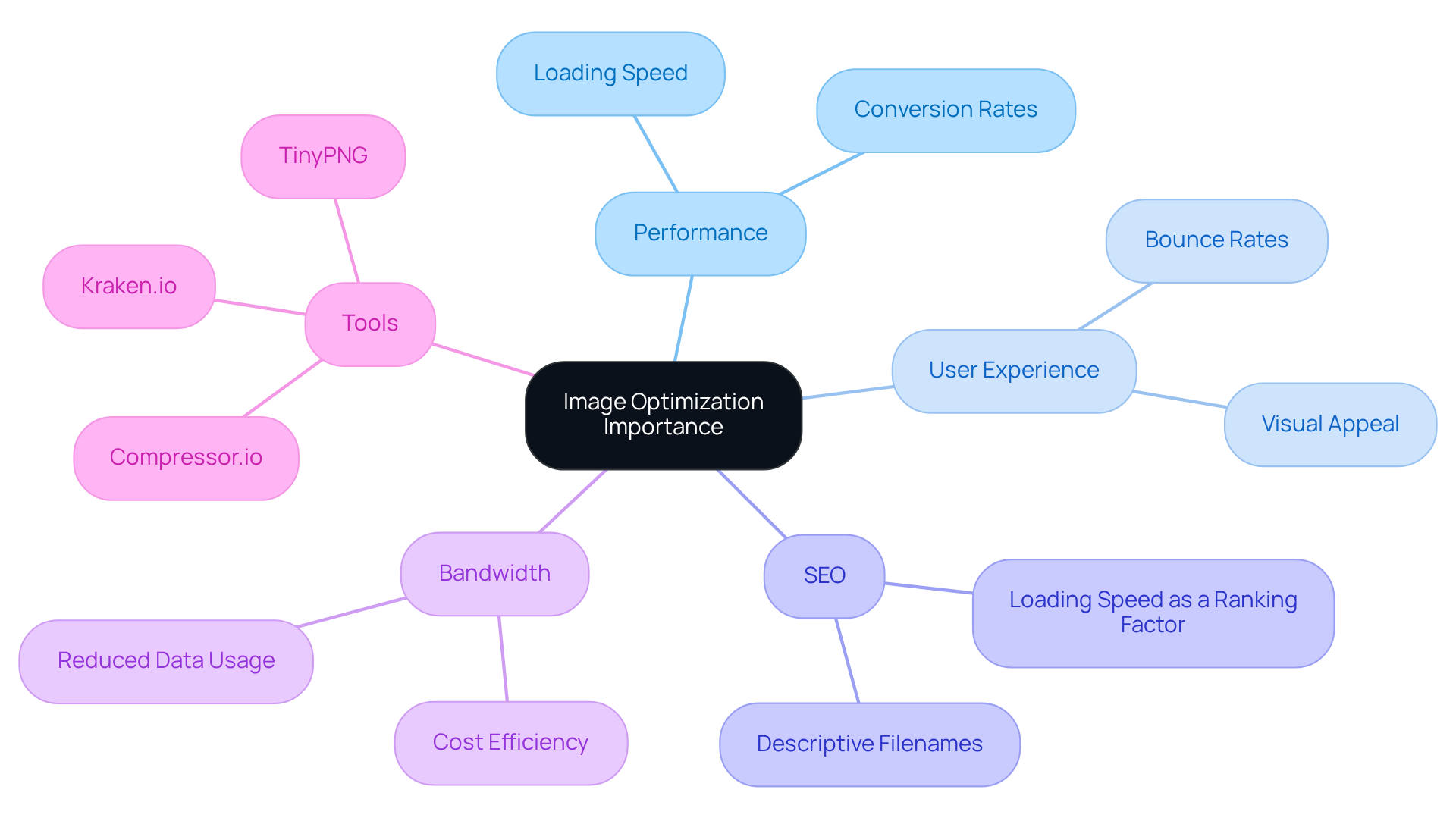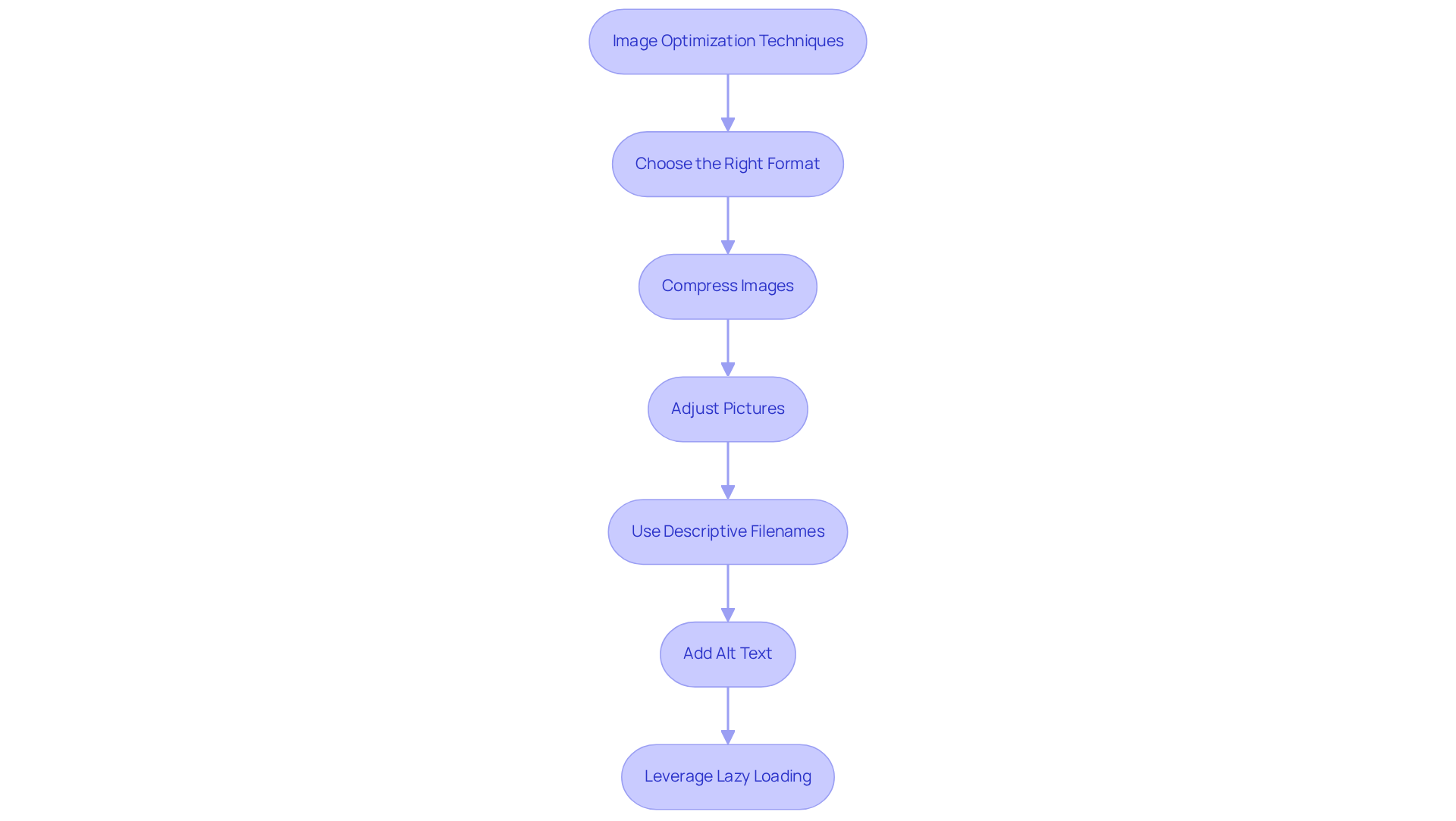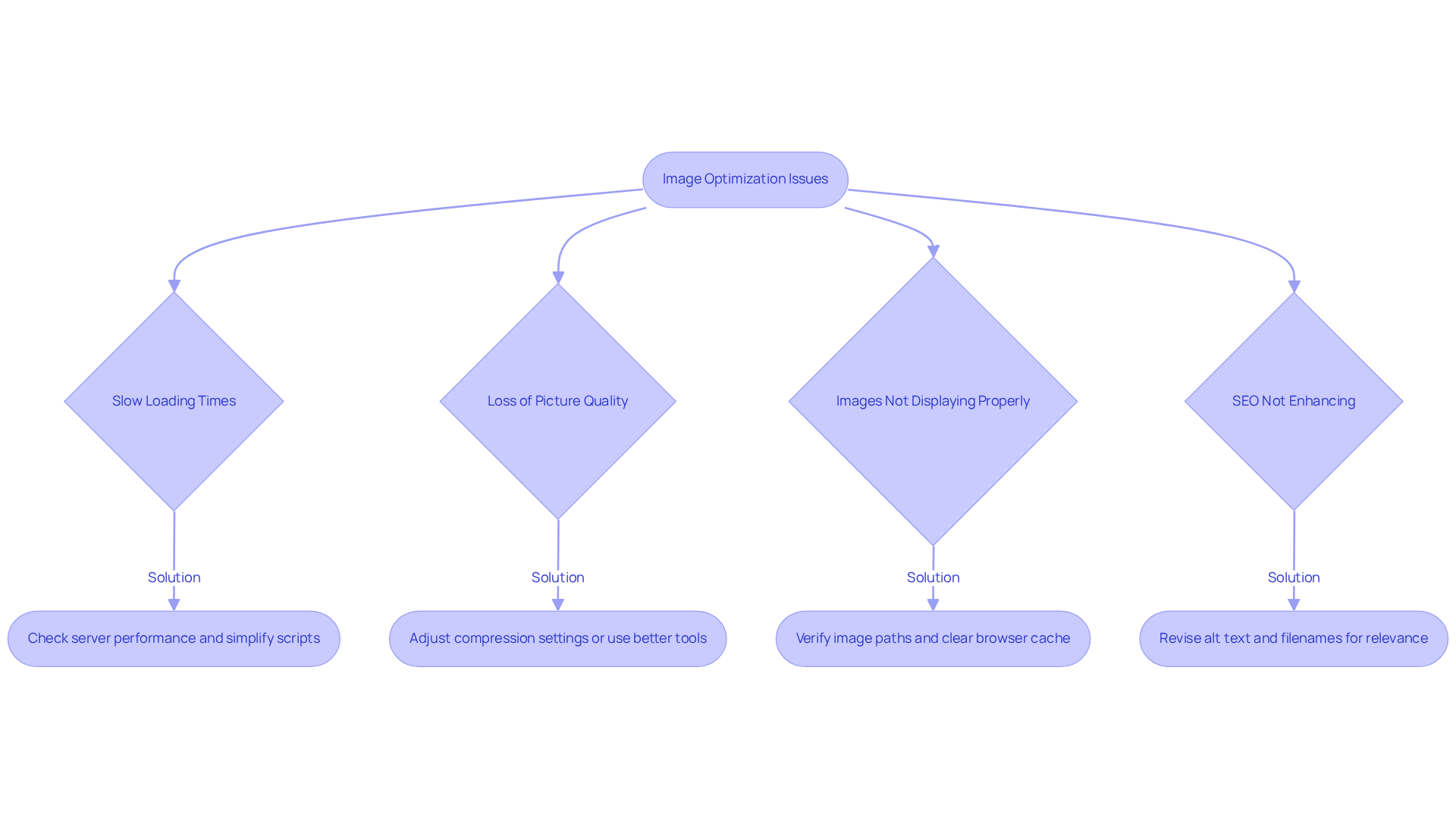Overview
Website optimization for images is a crucial concern for many tech startup founders, especially when it comes to enhancing site performance. Slow loading times can frustrate users, leading to disengagement and lost opportunities. Imagine a potential customer clicking away from your site simply because it took too long to load. This is a common pain point that many face, and it can feel overwhelming.
But there’s hope! By implementing effective image optimization techniques, you can significantly reduce loading times and improve user engagement. Consider the importance of:
- Choosing the right image formats
- Compressing files effectively
- Using descriptive alt text
These strategies not only contribute to faster load times but also enhance your SEO, ultimately leading to a more satisfying browsing experience for your users.
We understand the challenges you face, and we’re here to support you. By taking these steps, you can create a more welcoming online environment that encourages users to stay and explore. Remember, every small change can make a big difference in how your audience interacts with your site. Let’s work together to ensure your website reflects the quality and care you put into your business.
Introduction
Website performance is often a source of stress for many, especially when it comes to optimizing images. In the rush to create visually stunning content, it’s easy to overlook how crucial this aspect is. Properly optimized images not only enhance user experience but also significantly impact search engine rankings and help reduce bounce rates. But here’s the dilemma: how can you, as a website owner, strike the right balance between high-quality visuals and the need for speed?
This is a common struggle, and it can feel overwhelming. You want your site to look great, but you also want it to perform well. The good news is that there are effective techniques and solutions available to help you master image optimization. By ensuring that every visual element on your site contributes positively to its overall performance, you can create a more engaging experience for your users. Let’s explore these essential strategies together, so you can feel confident in your website’s ability to shine.
Understand the Importance of Image Optimization
Website optimization images is a crucial aspect of web design that can significantly improve your website's performance. Many of us have experienced the frustration of waiting for a page to load, and it’s a common problem that can lead to lost visitors and opportunities. Did you know that users expect content to load within three seconds? If it takes longer, they might just abandon your site altogether. In fact, a mere one-second delay in page load time can decrease conversions by up to 7%. Thankfully, tools like TinyPNG, Kraken.io, and Compressor.io can help you optimize your images without sacrificing quality.
When images load quickly, they create a seamless browsing experience that keeps visitors engaged. This not only reduces bounce rates but also enhances user satisfaction. Imagine your visitors enjoying clear, appealing visuals that draw them in. To achieve this, it’s essential to use the recommended resolution of:
- 72 pixels per inch (PPI) for standard web graphics
- 144 PPI for retina screens
This ensures optimal quality.
Moreover, let’s talk about SEO. Search engines like Google consider loading speed as a ranking factor. By refining your visuals as part of website optimization images, you can boost your site’s visibility in search results, leading to increased traffic. Websites that load faster are more likely to rank higher, as slow-loading pages can frustrate visitors and negatively impact search engine rankings. Additionally, using descriptive filenames and adding alt text to your images can further enhance your SEO efforts, as missing alt text can lead to penalties in search algorithms.
Another important aspect is bandwidth consumption. Smaller file sizes mean less bandwidth usage, which is especially beneficial for users on mobile devices or those with limited data plans. This efficiency not only improves the experience for your visitors but can also contribute to website optimization images, helping to reduce hosting costs for high-traffic websites.
By recognizing these advantages and understanding that visual optimization is an ongoing process requiring regular updates and assessments, you can appreciate the importance of investing in effective image enhancement strategies. This commitment will not only improve your site’s performance but also foster better user interaction, creating a more welcoming online environment for everyone.

Implement Effective Image Optimization Techniques
Optimizing your images is a crucial part of website optimization images, and it can feel overwhelming, especially when you’re trying to make your website shine. Many startup founders struggle with this, and it’s understandable—images are crucial for engaging visitors, but they can also slow down your site if not handled properly. Let’s explore some techniques that can help you tackle this challenge with confidence.
-
Choose the Right Format: It’s essential to select the right format for your images. JPEG works wonders for photographs due to its compression capabilities, making it perfect for rich, detailed visuals. On the other hand, PNG is your go-to for graphics that need transparency, while SVG is ideal for logos and icons that must remain clear at any resolution. Choosing the right format can significantly impact your site’s performance.
-
Compress Images: You don’t have to sacrifice quality for size. Tools like TinyPNG or ImageOptim can help you compress your images without losing their essence. Aim for a compression rate that keeps your visuals looking great while speeding up load times. For instance, WebP can reduce file sizes by 25-34% compared to JPEG or PNG, all while maintaining or even enhancing quality—this is especially beneficial for mobile users.
-
Adjust Pictures: It’s important to ensure your visuals are sized correctly for their display context. A hero graphic, for example, should be around 2500px wide and ideally under 500 KB. Avoid uploading larger files that could slow down your site. By adjusting your images to their true display dimensions, you can enhance performance and user experience.
-
Use Descriptive Filenames: Renaming your image files with relevant keywords can boost your SEO efforts. Instead of generic names like 'IMG_1234.jpg', consider using descriptive titles such as 'blue-running-shoes.jpg'. This small change can make a big difference in how easily your content can be found and organized.
-
Add Alt Text: Don’t overlook the importance of alt text. Including concise and descriptive alt text for each visual not only aids in SEO but also makes your content more accessible for users with disabilities. Aim for descriptions that are helpful, short, and include a keyword, while avoiding unnecessary filler words.
-
Leverage Lazy Loading: Implementing lazy loading with the
loading='lazy'attribute can be a game-changer. This technique delays the loading of images until they’re about to enter the viewport, significantly improving initial load times—especially for pages packed with visuals. It’s a simple yet effective way to enhance user experience.
By embracing these techniques, you can ensure your website optimization images contribute positively to your website’s performance. Remember, optimizing images isn’t just about technicalities; it’s about creating a welcoming and efficient space for your visitors. You’ve got this!

Troubleshoot Common Image Optimization Issues
Even with the best efforts in website optimization images, you might still encounter some frustrating issues that can impact your site's performance. Let’s explore these common problems together and find effective solutions that can help you move forward:
-
Images Still Load Slowly: It’s disheartening when slow loading times persist, even after you’ve optimized your images. Factors like server response time or too many scripts on the page can contribute to this. Regularly checking your server performance and simplifying scripts can really help speed things up. Remember, every second of delay in page loading can decrease conversions by up to 7%. That’s a significant impact!
-
Loss of Picture Quality: If you notice that compression is affecting the quality of your images, don’t hesitate to adjust your compression settings or try a different tool that better preserves visual integrity. There are modern compression methods available that can significantly reduce file sizes without sacrificing quality. As Nick Quirk wisely points out, by using website optimization images to compress your visuals and reduce file size, you provide your site with a speed boost.
-
Pictures Not Displaying Properly: It can be frustrating when images don’t show up as they should. Double-check that your image paths are correct and that your visuals are uploaded to the right directories. Sometimes, simply clearing your browser cache can help display the latest changes.
-
SEO Not Enhancing: If your optimized visuals aren’t boosting your SEO as expected, it might be time to revisit your alt text and filenames. Make sure they’re relevant and incorporate keywords effectively. Aligning your overall SEO strategy with your website optimization images is crucial, as well-structured visual data can enhance your search visibility.
Additionally, consider implementing image caching. This allows browsers to keep a copy of an image after its first load, saving bandwidth and speeding up future loads. By proactively addressing these challenges, you can streamline your website optimization images process to achieve the performance outcomes you desire. Regular audits and adjustments are key; studies show that optimized images can lead to faster loading times and improved user engagement. In fact, pages featuring optimized images can hold visitors' attention for an average of 88% longer than text-only pages.
You’re not alone in this journey, and with the right strategies, you can enhance your site’s performance and create a better experience for your users.

Conclusion
Optimizing images can feel like a daunting task, especially when you’re trying to create a seamless experience for your website visitors. Slow loading times can frustrate users, leading to dissatisfaction and even lost opportunities. It’s a challenge many website owners face, and it’s completely understandable to feel overwhelmed by the technical aspects of image optimization. But here’s the good news: by focusing on effective techniques, you can significantly enhance your site’s performance and user experience.
Imagine a visitor landing on your site, eager to explore what you have to offer, only to be met with lagging images. This scenario not only affects their experience but can also impact your SEO rankings and conversion rates. It’s crucial to address these pain points, as they directly influence how visitors perceive your brand. By selecting the right image formats, compressing files without sacrificing quality, and implementing lazy loading, you can create a more engaging online environment that keeps users coming back.
Moreover, don’t underestimate the power of descriptive filenames and alt text. These elements are vital for improving your site’s search visibility and ensuring that your content reaches the right audience. Regularly assessing and adjusting your image optimization strategies can help you tackle common issues like slow loading times and quality loss, reinforcing the importance of this ongoing commitment.
Ultimately, mastering image optimization not only enhances your website’s functionality but also fosters a welcoming atmosphere for users. Embracing these techniques can lead to a more efficient and visually appealing site, encouraging visitors to engage more deeply with your content. As the digital landscape evolves, prioritizing image optimization will remain a key factor in achieving online success and staying ahead of the competition. Remember, you’re not alone in this journey; by sharing experiences and learning from one another, we can all create better online spaces together.
Frequently Asked Questions
Why is image optimization important for websites?
Image optimization is crucial for improving website performance, reducing page load times, enhancing user satisfaction, and decreasing bounce rates. It also plays a role in SEO, as faster-loading websites are more likely to rank higher in search results.
What is the expected loading time for website content?
Users expect website content to load within three seconds. If it takes longer, they may abandon the site, with even a one-second delay potentially decreasing conversions by up to 7%.
What tools can help optimize images without sacrificing quality?
Tools like TinyPNG, Kraken.io, and Compressor.io can assist in optimizing images effectively while maintaining quality.
What are the recommended resolutions for web graphics?
The recommended resolution is 72 pixels per inch (PPI) for standard web graphics and 144 PPI for retina screens to ensure optimal quality.
How does image optimization affect SEO?
Image optimization can improve SEO by enhancing loading speed, which is a ranking factor for search engines like Google. Additionally, using descriptive filenames and adding alt text to images can further boost SEO efforts.
What are the benefits of reducing image file sizes?
Smaller image file sizes lead to less bandwidth consumption, which is beneficial for users on mobile devices or those with limited data plans. It also helps reduce hosting costs for high-traffic websites.
Is image optimization a one-time process?
No, image optimization is an ongoing process that requires regular updates and assessments to continually improve website performance and user interaction.




